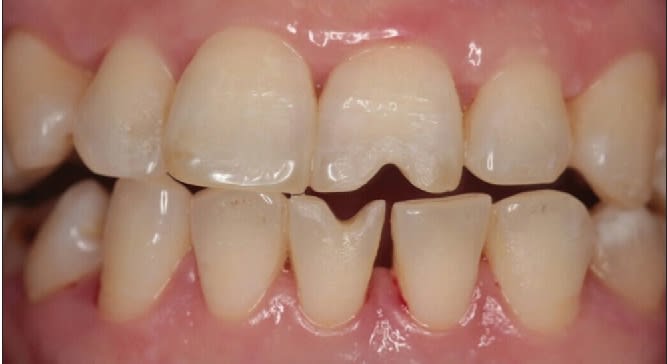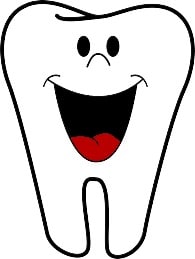
Tooth enamel is the hardest structure in the body, even harder than bone. It is meant to withstand a lifetime of biting and chewing forces. However, various forms of tooth wear can occur over time.
Understanding Tooth Wear
This video is a helpful introduction to the topic of tooth wear. Dental attrition, dental erosion, dental abrasion and dental abfraction are the four main types of tooth wear that we will look at below.
Normal tooth wear
When permanent incisor teeth first erupt through the gum, three small rounded bumps on the biting edge of each tooth will be visible. These are known as mamelons and are naturally worn off early in the life of the tooth.
Dental Attrition
Dental attrition is a type of tooth wear caused by tooth-to-tooth contact, usually where the teeth meet on the biting edges. Well-defined, sharp, flat and shiny wear marks, known as 'facets', will appear on molar and premolar tooth cusps or ridges. Attrition on front teeth results in matching wear patterns between top and bottom teeth. Tooth grinding (bruxism) is a main cause of this type of tooth wear.
Ways to prevent dental attrition
- exercise to help alleviate stress, a major cause of tooth grinding
- relaxation therapies - yoga, massage, meditation
- be aware - teeth should only touch when you're chewing or swallowing
- seek help - talk therapy to reduce severe anxiety/stress
- take a warm bath before bed to relax jaw muscles
- wear a protective dental night guard
- be assessed for sleep apnea which is associated with tooth grinding
- be assessed and treated for misaligned teeth to even out biting and chewing forces
Dental Erosion
Dental erosion happens when acids wear away the enamel on teeth. Tooth enamel is white. Dentin, the sensitive tissue located below the enamel, is yellow. As tooth enamel is lost, the teeth develop more of a yellow tinge and may become more sensitive. Teeth may also appear thinner or smaller than normal and the edges of front teeth can have a transparent look.
Four main causes of dental erosion
- Gastric Reflux - Digestive health can affect teeth. For those who suffer from gastroesophageal reflux, also known as acid reflux or GERD, stomach acids reach the mouth throughout the day. When these gastric acids travel up the throat and into the mouth they can wear away tooth enamel, usually on the inside surfaces of teeth, as well as the biting surfaces of molars.
- Bulimia - Persons with bulimia may secretly binge, eating large amounts of food and then purge to rid themselves of the extra calories. As they do so, the acids associated with purging have an erosive effect on the teeth. It is mostly the inside of the upper teeth that is affected.
- Carbonated Beverage Abuse - It's the bubbly fizz that lowers the pH and raises the acid level of any beverage. Swishing carbonated beverages results in the tooth structure on the front surface of upper teeth being eroded away resulting in a yellowish, dished-out area near the gum line. Pooling, or letting the beverage rest in the mouth, results in more tooth wear on the biting surface of lower molars.
- Citrus Fruit Abuse - Sucking on lemons, limes or highly acidic fruits can result in erosion of the front surface of tooth enamel on front teeth. The high acid content in many fruits and fruit juices can cause tooth enamel to weaken and demineralize over time.
Ways to prevent dental erosion
- avoid dry mouth to ensure there is enough saliva to buffer mouth acids and remineralize tooth enamel
- use toothpastes that strengthen teeth to make them more resistant to mouth acids
- maintain regular dental visits to assess for signs of tooth erosion
- seek assistance from a physician to treat the underlying causes of acid reflux
- avoid unhealthy weight-control behaviours such as self-induced vomiting
- seek the assistance of a relative, friend or physician at the earliest sign of an eating disorder
- limit or avoid sports drinks due to high amounts of sugar which form acids in the mouth
- drink carbonated beverages in moderation, no more than one per day - this includes soda pop, kombucha, sparkling water & any beverage that fizzes
- drink carbonated, sugary or fruit beverages quickly to reduce the time that sugars and acids are in contact with teeth
- limit fruit juices
- use a straw when drinking harmful beverages to keep acids away from teeth
- avoid swishing or pooling carbonated beverages in the mouth
- avoid sour candies
- after acidic meals or beverages, rinse your mouth with water, drink milk or eat a piece of hard cheese to neutralize mouth acids
- wait 30 minutes before brushing teeth after drinking a carbonated beverage or eating an acidic fruit when recently acid-attacked tooth enamel can be more easily worn away
- never suck on lemons, limes or any highly acidic fruit
Dental Abrasion

Dental abrasion is a progressive loss of tooth structure caused by mechanical actions other than chewing. Most often it is associated with incorrect toothbrushing technique and results in wearing away of tooth structure at the junction of the crown and the root of teeth near the gum line. Dental abrasion is also seen in individuals who use their teeth as a tool (e.g., to remove bottle tops, to crack open sunflower seeds, to hold pins, clips or nails). Those who have coarse diets can cause tooth wear which would be classified as dental abrasion. The long-term use of tongue jewellery can also cause dental abrasion, when the jewellery hits or rubs against the teeth.
Ways to prevent dental abrasion
- adopt a correct toothbrushing technique - use a pen-grip and avoid vigorous horizontal scrubbing actions with a hard toothbrush
- consider the level of abrasiveness of toothpaste
- select a toothpaste with properties that strengthen teeth and make tooth enamel more resistant to abrasive actions
- teeth should not be used as a tool to grip or hold items
- long-term use of tongue jewellery should be avoided
- select plastic vs. metal tongue jewellery
Dental Abfraction
When heavy or uneven forces are applied, teeth can flex and the result is breakdown of tooth structure and wedge-shaped notching at the gum line. This notching is seen at the neck of the tooth and can be detected when a fingernail catches on the area. The mechanical stress of clenching or grinding and mouth acids contribute to this process.
Ways to prevent dental abfraction
- have misaligned teeth repositioned so that teeth mesh well and biting forces are even
- have selective teeth reshaped so that excessive biting forces on individual teeth are reduced or eliminated
- avoid clenching or grinding
- adopt stress-reduction or relaxation therapies
- wear a night guard as needed
- limit acidic foods and drinks
- when indicated, have dental fillings placed in abfraction areas to reinforce tooth structure and prevent deeper notching
 Understanding the various causes of tooth wear and ways to prevent them is a key factor in maintaining a healthy smile. Our Lorne Park Dental Associates’ team routinely checks for early signs of tooth wear and offers preventive strategies when needed. Contact us today.
Understanding the various causes of tooth wear and ways to prevent them is a key factor in maintaining a healthy smile. Our Lorne Park Dental Associates’ team routinely checks for early signs of tooth wear and offers preventive strategies when needed. Contact us today.
